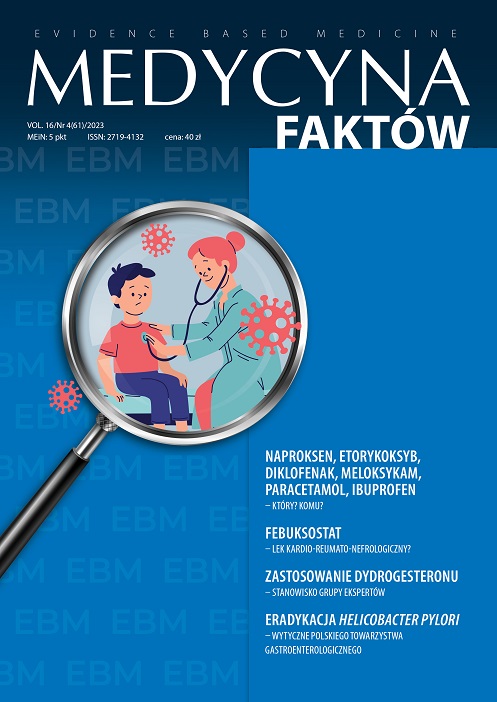Bromek ipratropium w leczeniu kaszlu – nowe spojrzenie Artykuł przeglądowy
##plugins.themes.bootstrap3.article.main##
Abstrakt
Kaszel ostry jest bardzo częstą dolegliwością, wywołaną najczęściej przez infekcje górnych dróg oddechowych. W większości przypadków ma charakter samoograniczający się, czasem jednak wymaga zastosowania leków. Z kolei kaszel przewlekły może być objawem wielu różnych chorób, a jego leczenie opiera się zazwyczaj na leczeniu przyczynowym. Wśród leków zmniejszających kaszel, poza lekami przeciwkaszlowymi i mukoaktywnymi, znajduje się bromek ipratropium. Jest on zalecany w postaci wziewnej w łagodzeniu kaszlu ostrego związanego zarówno z ostrymi infekcjami górnych, jak i dolnych dróg oddechowych, w kaszlu poinfekcyjnym oraz w kaszlu przewlekłym związanym z przewlekłym zapaleniem oskrzeli lub przewlekłą obturacyjną chorobą płuc. Dodatkowo bromek ipratropium w postaci aerozolu donosowego może być pomocny w leczeniu kaszlu przewlekłego związanego z przewlekłym niealergicznym nieżytem nosa, zwłaszcza naczynioruchowym.
##plugins.themes.bootstrap3.article.details##
Copyright © by Medical Education. All rights reserved.
Bibliografia
2. Irwin RS, Chang AB, Altman KW. On behalf of the CHEST Expert Cough Panel. Classification of cough as a symptom in adults and management algorithms: CHEST Guideline and Expert Panel Report. Chest. 2018; 153(1): 196-209.
3. Irwin RS, Baumann MH, Bolser DC et al. Diagnosis and management of cough. ACCP evidenced-based clinical practice guidelines. Chest. 2006; 129(1 suppl): 1S-23S.
4. Witek TJ, Ramsey DL, Carr AN et al. The natural history of community-acquired common colds symptoms assessed over 4-years. Rhinology. 2015; 53(1): 81-8.
5. Hryniewicz W, Albrecht P, Radzikowski A. Rekomendacje postępowania w pozaszpitalnych zakażeniach układu oddechowego. Narodowy Program Ochrony Antybiotyków. Narodowy Instytut Leków, Warszawa 2016.
6. Krenke R, Chorostowska-Wynimko J, Dąbrowska M et al. Postępowanie w kaszlu u osób dorosłych – rekomendacje dla lekarzy rodzinnych. Lekarz POZ. 2018; 6(4): 425-52.
7. Kardos P, Dinh QT, Fuchs KH et al. German Respiratory Society guidelines for diagnosis and treatment of adults suffering from acute, subacute and chronic cough. Respiratory Medicine. 2020; 170: 105939.
8. Morice AH, Millqvist E, Bieksiene K et al. ERS guidelines on the diagnosis and treatment of chronic cough in adults and children. Eur Respir J. 2020; 55(1): 1901136.
9. Canning BJ, Chang AB, Bolser DC et al. Anatomy and neurophysiology of cough: CHEST Guideline and Expert Panel report. Chest. 2014; 146(6): 1633-48.
10. Mazzone SB, Farrell MJ. Heterogeneity of cough neurobiology: Clinical implications. Pulm Pharmacol Ther. 2019; 55: 62-6.
11. NICE guideline [NG120]. Cough (acute): antimicrobial prescribing. 2019.
12. Smith SM, Schroeder K, Fahey T. Over-the-counter (OTC) medications for acute cough in children and adults in community settings. Cochrane Database Syst Rev. 2014; 11: CD001831. http://doi.org/10.1002/14651858. CD001831.pub5.
13. Malesker MA, Callahan-Lyon P, Ireland B et al. CHEST Expert Cough Panel. Pharmacologic and Nonpharmacologic Treatment for Acute Cough Associated With the Common Cold: CHEST Expert Panel Report. Chest. 2017; 152(5): 1021-37.
14. Lee AM, Jacoby DB, Fryer AD. Selective muscarinic receptor antagonists for airway diseases. Curr Opin Pharmacol. 2001; 1(3): 223-9.
15. Charakterysyka Produktu Leczniczego.
16. Zanasi A, Lecchi M, Del Forno M et al. A randomized, placebo-controlled, double-blind trial on the management of post-infective cough by inhaled ipratropium and salbutamol administered in combination. Pulm Pharmacom Ther. 2014: 29(2): 224-32.
17. Bateman ED, Rennard S, Barnes PJ et al. Alternative mechanisms for tiotropium. Pulmon. Pharmacol. Ther. 2009; 22(6): 533-42.
18. Korpas J, Widdicombe JG. Aspects of the cough reflex. Respir Med. 1991; 85 Suppl A: 3-5.
19. Dicpinigaitis PV, Spinner LM, Santhyadka GS et al. Effect of tiotropium on cough reflex sensitivity in acute viral cough. Lung. 2008; 186(6): 369-74.
20. Holmes PW, Barter CE, Pierce RJ. Chronic persistent cough: use of ipratropium bromide in undiagnosed cases following upper respiratory tract infection. Respir Med. 1992; 86(5): 425-9.
21. Lowry R, Wood A, Higenbottam T. The effect of anticholinergic bronchodilator therapy on cough during during upper respiratory tract infections. Br J Clin Pharmacol. 1994; 37(2): 187-91.
22. Global Initiative for Chronic Obstructive Lung Disease. Global Strategy for the Diagnosis, Management, and Prevention of Chronic Obstructive Pulmonary Disease: 2023 Report.
23. Appleton S, Jones T, Poole P et al. Ipratropium bromide versus long-acting beta-2 agonists for stable chronic obstructive pulmonary disease. Cochrane Database Syst Rev. 2006; 2006(3): CD006101.
24. Calzetta L, Ritondo BL, Zappa MC et al. The impact of long-acting muscarinic antagonists on mucus hypersecretion and cough in chronic obstructive pulmonary disease: a systematic review. Eur Respir Rev. 2022; 31(164): 210196.
25. Kesten S, Casaburi R, Kukafka D et al. Improvement in self-reported exercise participation with the combination of tiotropium and rehabilitative exercise training in COPD patients. Int J Chron Obstruct Pulmon Dis. 2008; 3(1): 127-36.
26. Vogelmeier C, Hederer B, Glaab T et al. Tiotropium versus salmeterol for the prevention of exacerbations of COPD. N Engl J Med. 2011; 364(12): 1093-103.
27. Decramer ML, Chapman KR, Dahl R et al. Once-daily indacaterol versus tiotropium for patients with severe chronic obstructive pulmonary disease (INVIGORATE): a randomised, blinded, parallel-group study. Lancet Respir Med. 2013; 1(7): 524-33.
28. El Khoury P, Abou Hamad W, Khalaf MG et al. Ipratropium Bromide Nasal Spray in Non-Allergic Rhinitis: A Systematic Review and Meta-Analysis. The Laryngoscope. 2023; 133(12): 3247-55.
29. Dąbrowska M, Arcimowicz M, Grabczak EM. Chronic cough related to the upper airway cough syndrome: one entity but not always the same. Eur Arch Otorhinolaryngol. 2020; 277(10): 2753-59.
30. Hellings PW, Klimek L, Cingi C et al. Non-allergic rhinitis: Position paper of the European Academy of Allergy and Clinical Immunology. Allergy. 2017; 72(11): 1657-65.
